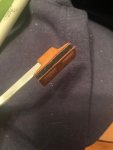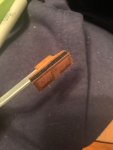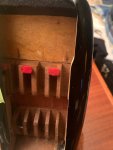partly this depends on whether you are refurbing this accordion to keep and use,
or to just make it decent then pass it along to a new owner...
personally, i think the long felt on the leading edge of the keybed
(where the bottom tip of the front of the key touches)
helps reduce noise and improves feel so i always replace this
secondly, regarding noise in general, there are several sections
of the keybed where adding a layer of felt purely for sound
absorption and resistance to sound bounce can be done...
you just have to study it with a key in and see where it
touches and where it doesn't, you don't want to impede the
motion of the spring of course
also i tend to like to refresh any exposed wood with a nice
soft dab of old fashioned Johnsons Paste wax... this will help the
spring "slip more easily in it's little groove, and it will help the
rod and pivot area too... especially areas of wood that were never
varnished in any way as it helps resist bugs too. I use a soft small paintbrush
and apply the wax very lightly
These specific pallets look fat and happy, the felt is still evenly parallel shaped
(not beaten down until they have a taper) and the leather
looks nice. Do you notice how the leather has taken on two
small bellies where it projects into the square holes ? sometimes
if this is very pronounced there can be a sort of tiny "thwack" noise
produced from when it lifts (because that belly has sealed
slightly in/along the inside edge of the hole while closed
as over time it projected further in and took on the square shape)
the object is for the pallet to lift nicely and as evenly as possible,
quickly and cleanly allowing the air from all sides to flow
uninhibited into the hole and thus to the reed.. anything that
affects the delivery of air can have an affect on how the reed
responds, including a change in the flow or direction of the air.
and then of course it must seal perfectly when lowered all
around and at the same moment
Please also note that your pallets are firmly affixed to the
aluminum arm... note the arm itself... Older accordions had round
rods then the industry improved to using flat aluminum, which has
more resistance to bending (keys becoming unevenly leveled)
though it has less resistance to sideways bending (which is less
of a problem but sometimes noticeable)
Better design introduced various mounting systems that could
allow the pallets to self-level slightly, thereby improving the
perfection of the fit particularly over time. Rigidly mounted
pallets, like this one, are less desirable and of course cost less
during manufacture (though yours appear to be real wood,
which is preferred over plastic pallets in my opinion, as plastics
present a hard reflective surface to sounds and noise
finally, the aluminum plate with all those little square holes...
i have on occasion run super fine wet sanding paper carefully
and then cleaned and polished the aluminum to perfection
so that the leather valves will have no friction during liftoff...
of course this is a ridiculous level of finishing and may not actually
improve the action but i have done it on my keepers
enjoy your project !
ciao
Ventura



